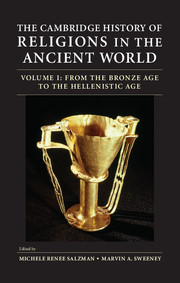Book contents
- Frontmatter
- Contents
- List of Figures and Maps
- List of Contributors
- List of Abbreviations
- Acknowledgments
- Introduction to Volumes I and II
- Introduction to Volume I
- Part I Mesopotamia and the Near East
- Part II Egypt and North Africa
- Part III Greece and the Eastern Mediterranean
- Part IV The Western Mediterranean and Europe
- 12 Etruscan Religion
- 13 Roman Religion through the Early Republic
- 14 Celtic Religion in Western and Central Europe
- Suggestions for Further Reading
- General Index
- Index of Citations
- Frontmatter
- Contents
- List of Figures and Maps
- List of Contributors
- List of Abbreviations
- Introduction to Volume II
- Part I Iran and the Near East
- Part II Egypt and North Africa
- Part III Greece and Asia Minor
- Part IV Italy, Roman Gaul, and Spain
- Suggestions for Further Reading
- General Index
- Index of Citations
- References
14 - Celtic Religion in Western and Central Europe
from Part IV - The Western Mediterranean and Europe
Published online by Cambridge University Press: 05 October 2013
- Frontmatter
- Contents
- List of Figures and Maps
- List of Contributors
- List of Abbreviations
- Acknowledgments
- Introduction to Volumes I and II
- Introduction to Volume I
- Part I Mesopotamia and the Near East
- Part II Egypt and North Africa
- Part III Greece and the Eastern Mediterranean
- Part IV The Western Mediterranean and Europe
- 12 Etruscan Religion
- 13 Roman Religion through the Early Republic
- 14 Celtic Religion in Western and Central Europe
- Suggestions for Further Reading
- General Index
- Index of Citations
- Frontmatter
- Contents
- List of Figures and Maps
- List of Contributors
- List of Abbreviations
- Introduction to Volume II
- Part I Iran and the Near East
- Part II Egypt and North Africa
- Part III Greece and Asia Minor
- Part IV Italy, Roman Gaul, and Spain
- Suggestions for Further Reading
- General Index
- Index of Citations
- References
Summary
An account of the religion of the Celts of Western and Central Europe is beset with many difficulties, the most significant being a debate over the existence of “the Celts” as a definable people with a common religious tradition. It is true that modern concepts of the Celts are only perhaps two hundred years old at most; but that a people known as Celts or Keltoi did exist in the ancient world, and that even beyond these tribes were others who had similar language, religion, and art, cannot be disputed. This commonality of culture is the determining factor for scholars in identifying the Celts, whose material remains may be traced from Ireland in the west to Romania and even Turkey in the east, to the north as far as southern Germany, and south to parts of the Iberian Peninsula and to Italy north of the Po River (see Map 10).
Granted this commonality of culture, scholars in search of creating as comprehensive a picture as possible of Celtic religious systems have heavily drawn on archaeological evidence from these regions to supplement the ancient written sources. Apart from the First Botorrita Inscription found in Spain, the Coligny Calendar, and the Chamalières and Larzac Tablets from France (Roman Gaul), some bilingual texts such as the Vercelli Inscription from Italy, and an occasional dedication, there is virtually nothing written by the Celts themselves relating to their religion. Writing had little or no part in their culture, and such inscriptions mostly used the Greek or Latin alphabets. Our main written sources, texts by Greek or Roman authors of the fifth century bce on, were not interested in giving a point of view that might reflect that of those whom they were describing. At best they portray the Celts with a certain sympathy; at worst the emphasis is on their barbarity and their “otherness,” and the ancient exaggerations and fabrications are repeated uncritically by successive writers. For example, the first-century-bce Greek historian Diodorus Siculus (5.32) writes of cannibalism in Ireland, and this is repeated half a century later by Strabo (Geog. 4.5.4) who adds incest to the crimes, although he concedes that he does not have “trustworthy witnesses” for his information.
- Type
- Chapter
- Information
- The Cambridge History of Religions in the Ancient World , pp. 364 - 386Publisher: Cambridge University PressPrint publication year: 2013
References
- 1
- Cited by



